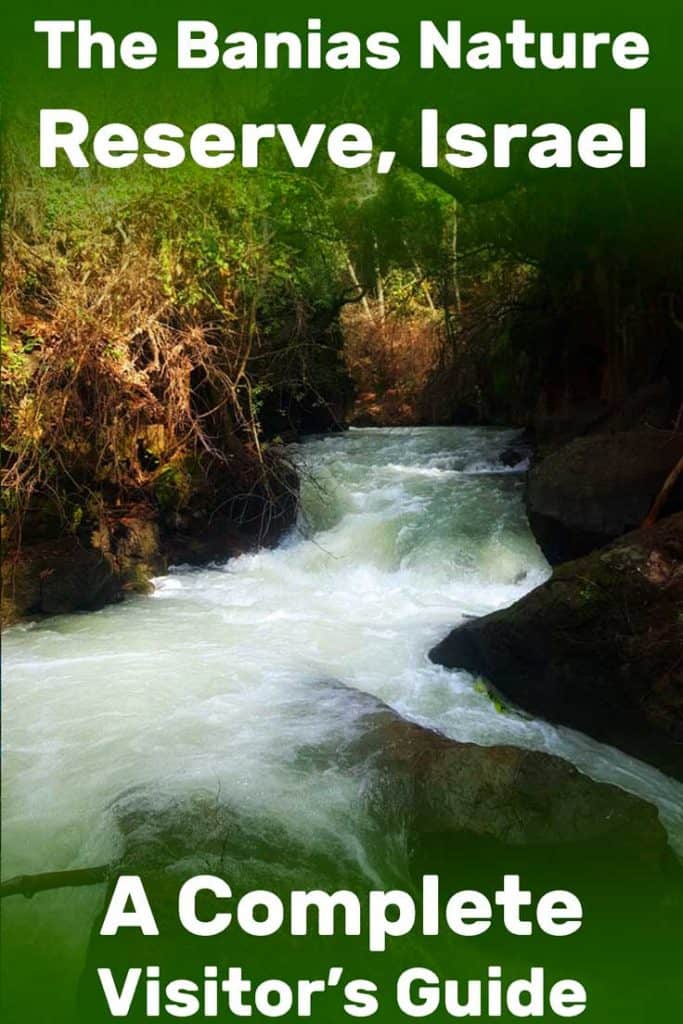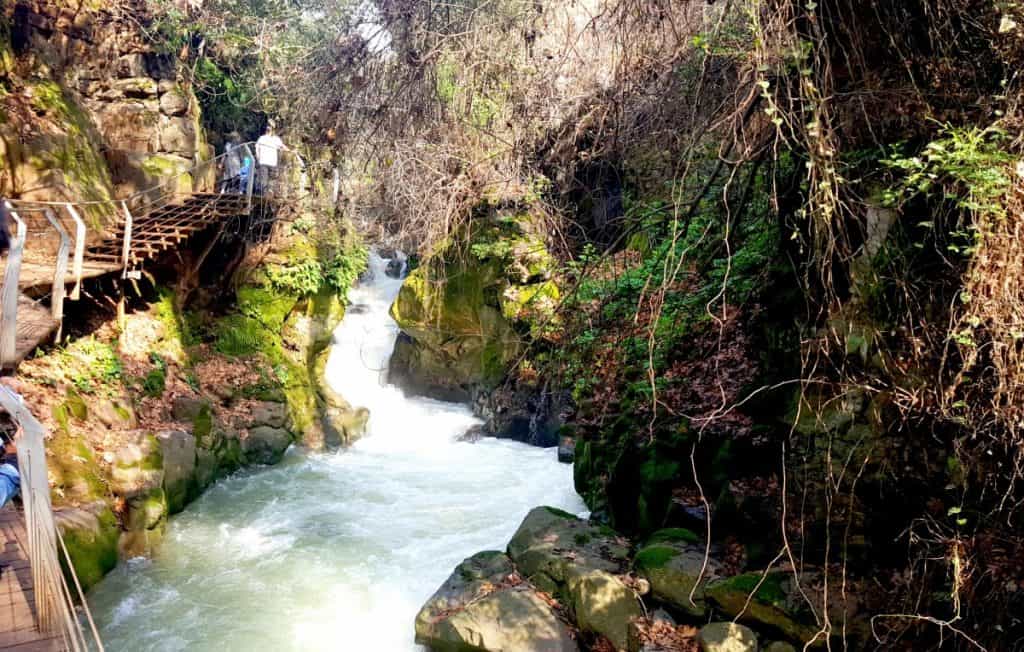Visiting the Banias Nature Reserve can easily become one of the highlights of your trip to Israel. This is a gem of a park that offers some of the most beautiful scenery you can find in the country, as well as an amazing collection of archeological remains. It's also one of our personal favorite places in Israel, so I'm happy to share with you today a concise guide for visiting the Banias Reserve.
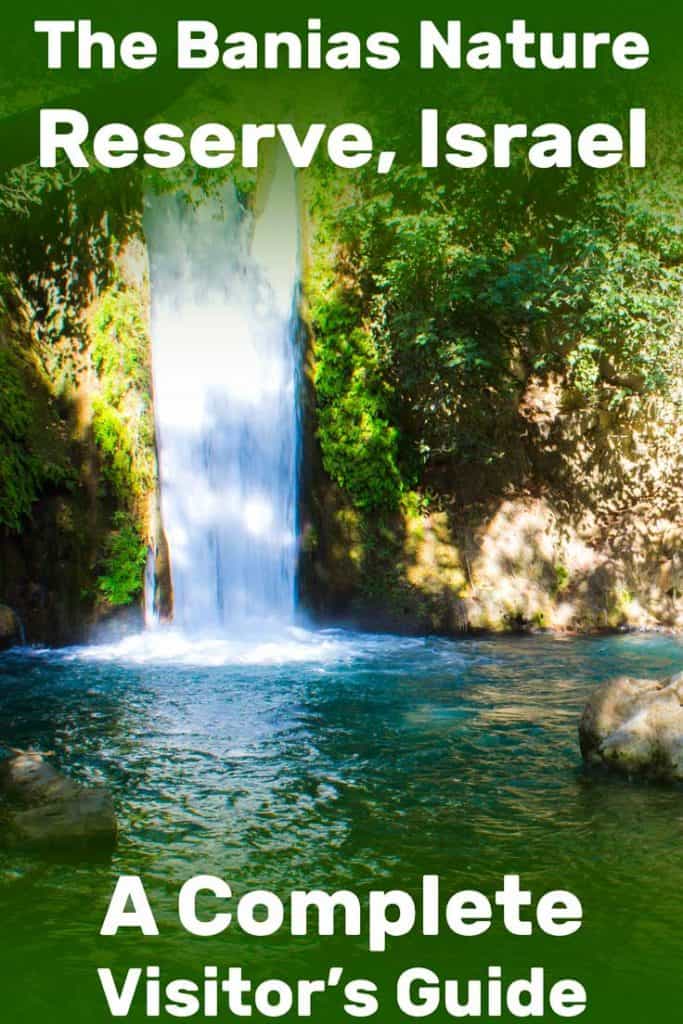
The Banias Nature Reserve is a small national park in the most northern part of Israel. This is a great destination any time of the year where you can spend anything between an hour to half a day. Highlights include -
- Exploring the archeological sites, including the cave of the god Pan, and the ancient synagogue.
- Admiring the largest waterfall in Israel
- Hiking along the suspended trail, right above the gushing stream.
Sounds good?
It really is. Keep reading for our overview of the reserve, along with tips and ideas based on our experience.
The Banias Nature Reserve - An Overview
If you like learning a bit about a place before coming as we do, this section is for you. Otherwise, feel free to scroll down for more practical travel advice.
The official name of the place is The Hermon Stream Nature Reserve. Most Israelis know it as "the Banias" and if you ask them about the Hermon stream, they may not even recognize the name. Banias is actually the Arab version of the name of the ancient settlement that was established here, some 2,400 years ago: Panias. As you tour the reserve, you'll be walking alongside the ruins of ancient Panias, but we'll get to that in a minute.
The Hermon stream has two sources -
- Springwater bubbling out of the ground at the eastern end of the reserve.
- Seasonal rainfall from Mount Hermon and the northern part of the Golan Heights.
That's why the stream is fullest during the spring months but retains a constant flow throughout the year. The constant presence of water allows for a beautiful concentration of vegetation, including trees, right along the stream. The water draws in wildlife too, with hyraxes being a constant feature in the reserve. During the nighttime, wild boars, jackals, and weasels show up as well.
The spring water first accumulates in ancient artificial pools near the location of the Shrine of the god Pan, in the eastern section of the reserve. They then flow through a ravine for a couple of miles before reaching the other side of the reserve and falling down the largest waterfall in the country.
The history of the Banias area
To say that the area is steeped in history would be an understatement (although that's true of the entire country). Pagan Greeks, Romans, Early Christians (including Jesus Christ himself!), Muslims, and Mamluks all claimed their stake here. In modern times, the area was under Syrian rule until 1967 when Israel took over in the Six-Day War.
Where is the Banias and how to get there
The Banias Nature Reserve is located in northern Israel, right on the edge of the Golan Heights -
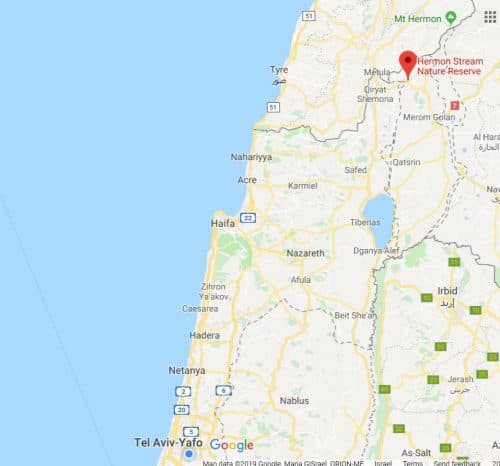
The park has two points of entry. I've put the two of them on this map and marked them with a "P" as that's where you park your car to start your tour -
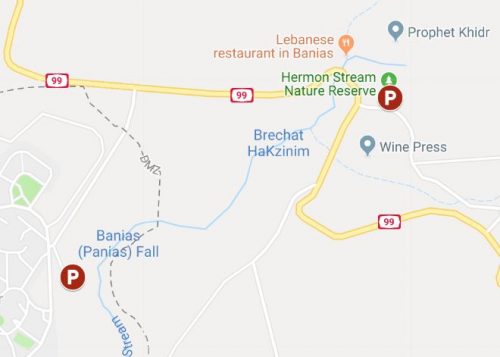
As you can see, the stream flows between the two points. There is a good hiking trail along the stream which connects the two entries. It takes about an hour to hike and you can certainly park your car in one of the two parking lots, then hike between the areas and back.
Alternatively, you can visit both areas consecutively, driving between them instead of hiking. Your daily ticket covers both entries.
How to get to the Banias Nature Reserve
The easiest and fastest way to get there is by car. If you're coming from the Tel Aviv area, this should take you about two and a half hours (mostly depending on traffic going out of Tel Aviv).
When searching for your destination in Waze or Google Maps, type "Hermon Stream (Banias) Nature Reserve". You could also try "Banias Waterfall".
Using public transportation is possible but it's going to take you a whole lot longer.
There is no bus stop at the reserve. Taking two or three different buses will get you to Sa'ar Fall on Road 99. From there, you'll have to walk for about one mile (1.5 kilometers) to get to the Banias reserve or try to hitchhike that section of the road.
The best way to figure out your bus routes is by using Google Maps. Just enter your point of origin in Israel and then "Hermon Stream Nature Reserve" as your destination, and select "public transportation" as your mode of transfer.
Overall, this is an area where you'd do much better with a car. Lots to see and places can be a 10-minute drive away - yet would take you an hour or two to cover the same distance by bus (if that's even doable).
Not sure about renting a car here? Read my posts about driving in Israel and about whether you should rent a car in Israel.
What to do in the Banias Nature Reserve
Essentially, this park has three areas:
- The west entrance (Banias Waterfall)
- The east entrance (Ancient Ruins)
- The hiking trails connecting the two.
To help you arrange your visit in the best possible way for your own preferences, I'm going to cover the points of interest by area. If you're pressed in time, you can decide on visiting the area in just one of the entrances.
The West Entrance
As you enter from this side of the park, you'll hike down into the canyon, where you can do one (or all) of the following -
1. The Banias Waterfall Viewpoint
The shortest route to the waterfall takes only a couple of minutes. This is the largest waterfall in Israel and it's really pretty!
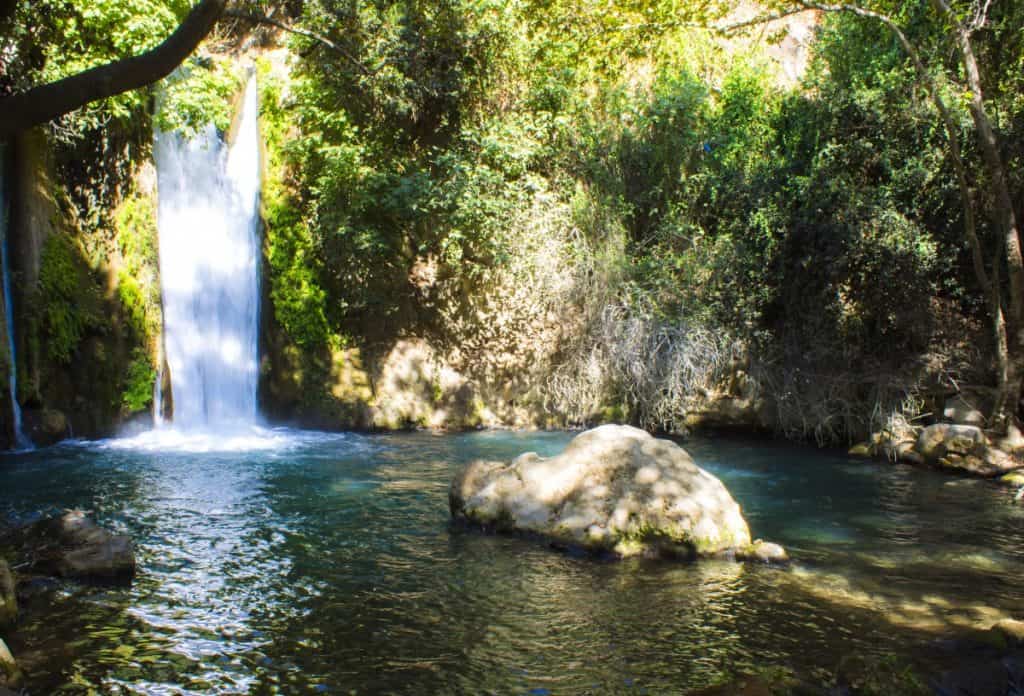
There is a clearly marked viewing point for the waterfall on a small wooden deck. You could just hike to the waterfall and back in about 10-15 minutes. The trail is well-marked and partially paved. It is a bit steep but good for families. It's not wheelchair accessible, as it has multiple steps.
2. The Hanging/Suspended Trail
A short section of the trail - about 80 yards/meters - takes you literally above the water, as you hike along a suspended trail inside the gorge.
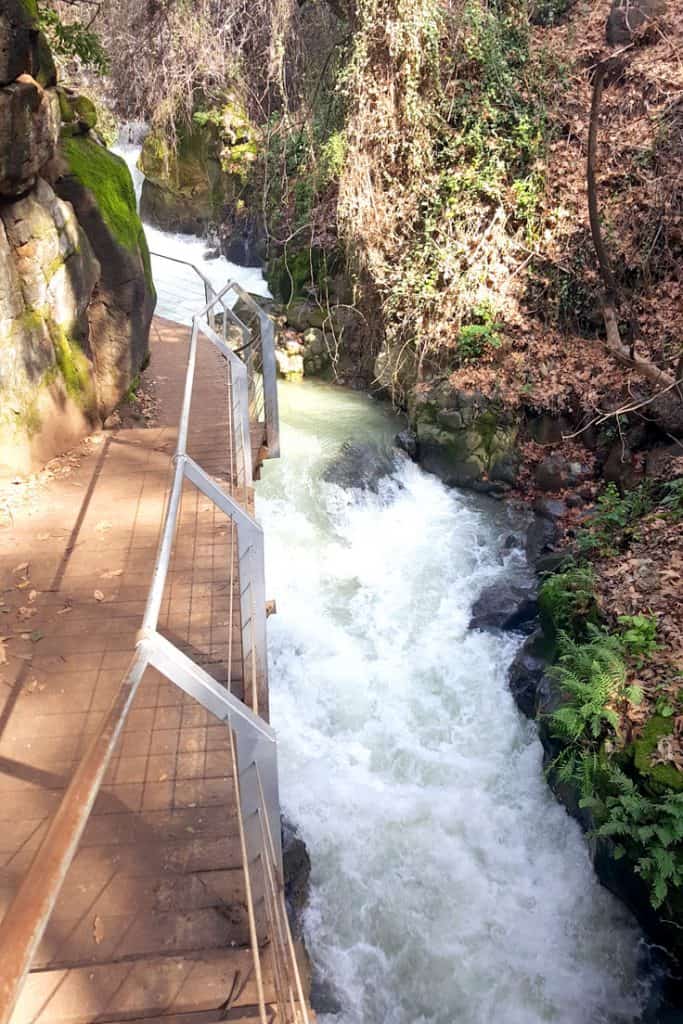
3. The red hiking trail
This is a loop trail that includes the suspended trail. It leads you to the intersection with the path to the waterfall, which adds a couple of minutes to your walk.
If you have half an hour to an hour, this is the way to experience this area of the reserve. Follow the red trail and where you see the sign to the waterfall, take that detour.
This is what you'll see along the trail. We took these pictures during a winter excursion to the Banias. If you come in summertime, there will be thick lush foliage on those trees.
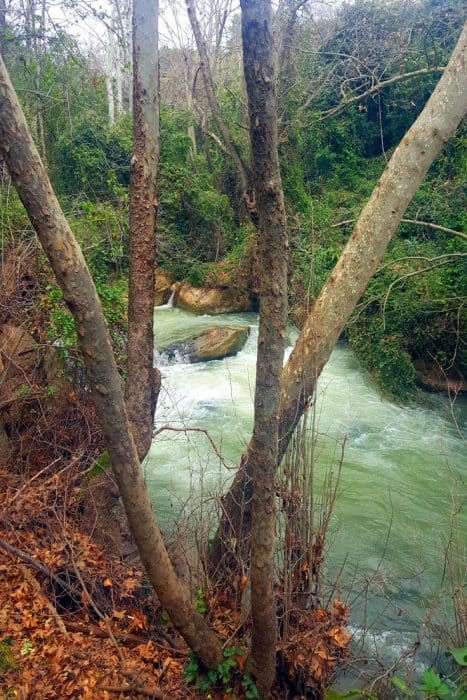
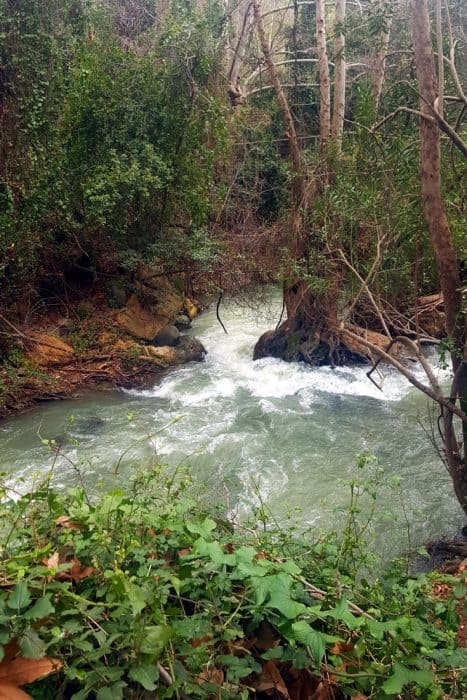
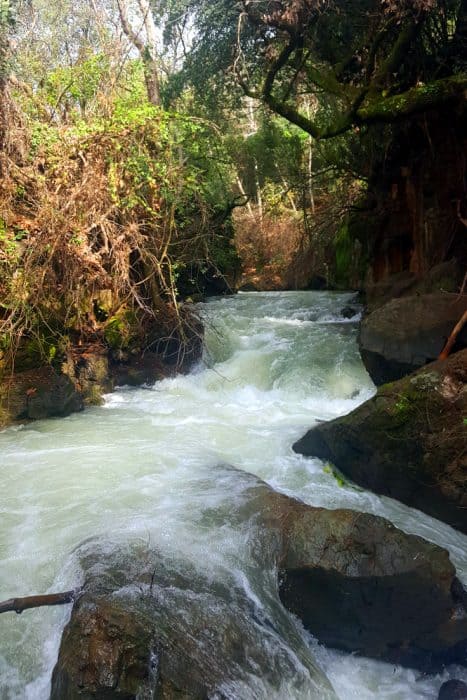
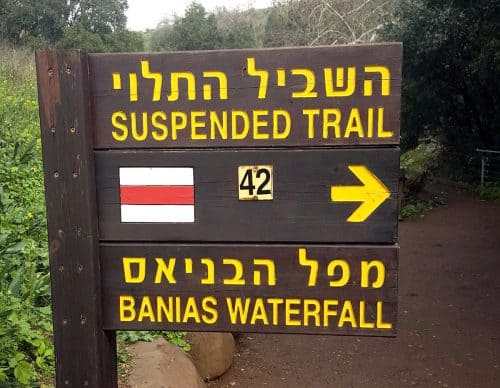
Everything is well signposted, and on weekends there will be park employees there, as well as many other visitors taking the same route as you.
The eastern entrance
This area is all about archeology. Several things to see here -
1. The Shrine of the god Pan & the pools
Right by the parking lot, as you enter the park, you'll find the remains of Herod's temple for the god Pan. Nearby you'll see the pools which were excavated around that time.
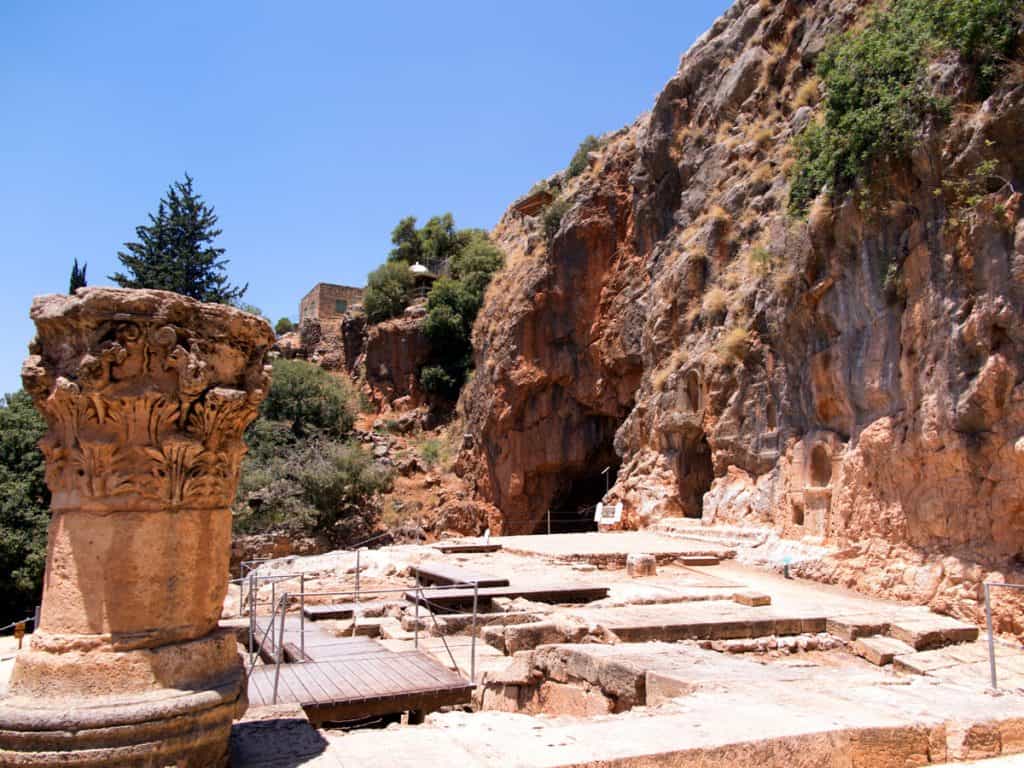
2. The Roman Bridge and the Crusader's Town
You can walk from the Pan area to the excavated fortified town from the time of the Crusaders, including the wall, gate towers, and the remains of a moat.
Going there, you'll be passing an even more ancient Roman bridge as well as archeological remains from other periods.
3. The Palace of King Agrippa II
You can also make your way to the third area of the complex, where you'll find the remains of a huge lavish palace from the first century. Experts believe the owner was King Herod Agrippa II. You can explore the palace while going underground (just follow the signs).
Hiking across the reserve
There's a good hiking trail along the stream, connecting the two sections of the reserve. It takes about an hour to cross and another area to get back. There's another trail that can be used when the trail along the stream is flooded or just too muddy.
1. The Officers' Pool
About 5-10 minutes of hiking from the eastern entrance towards the west, you'll come across the Officers' Swimming Pool. This is where the Syrian army built a small bathing pool out of concrete, to capture the relatively warm water of a local spring.
2. The Flour Mill
The trail ends (or begins) in the eastern section right next to a working flour mill. The Matroof flour mill still operates by the power of the stream water and local Druze families bring wheat here to turn it into flour.
If you visit on the weekend, there's often a Druze stand in this location, where you can buy local food, including a fresh Druze pita with cheese and olive oil.
How long should you allocate for your visit?
That depends. Many people just visit the hanging trail and waterfall which takes about one hour.
If you want to add a quick tour of the Pan shrine area, that would be another 45 minutes (including getting there and parking).
Hiking to the Agrippa Palace and back should take about 45 minutes. The same goes for hiking to the Crusaders town (in the other direction). And if you want to hike along the stream from one area to the other - that's another one hour in each direction.
These time estimates are for families or anyone who wants to take their time, read the signs etc. If you're on your own and tend to move quickly, you could cut the times by half.
So, the Banias can be a quick one-hour stop on your way to the northern slopes of the Golan Heights, focusing on either the waterfall or the Pan shrine area. Alternatively, it can be a 4-5 hour-long visit. Or anything in between.
Visiting times and fees
During summertime, the reserve is open between 8 AM and 5 PM Saturday-Thursday. Fridays, they close at 4. If it's the eve of a Jewish holiday, they close at 1 PM. You can read here more about holidays in Israel and how they may affect your trip.
Winter hours are the same as above, except they close everything one hour earlier.
Note that the gates and ticket offices close one hour before the official closing time. By closing time, you need to vacate the park.
How much does it cost to visit the Banias Nature Reserve?
Tickets cost 28 shekels (roughly $8) for an adult and half of that for kids under 18.
If you plan on visiting more than three national parks, check out the discount passes for tourists here.
Where to eat?
If you're in a rush and a quick bite will do, both entries to the reserve have food stands where you can get snacks, drinks, coffee, and ice cream.
On weekends and busy days, they also have Druze food stands where you can buy local produce and usually fresh pita bread with fillings.
If you have time for a more substantial meal, our personal favorite is the Lebanese Restaurant. It's about 2 minutes away from the eastern entrance to the park. Just enter "Lebanese restaurant Banias" in Waze or Google Maps and they'll take you there.
This is a family-owned Druze restaurant with good fresh local food and you can choose to sit outside, right next to the flowing water of the Banias. Beautiful - but can get loud!
Where to stay?
Being only two and a half hours away from Tel Aviv means this is a popular day-trip destination for Israelis.
However, if you're traveling to Israel from abroad, definitely work this into a longer itinerary in the north of Israel. Nearby attractions include the Nimrod Fortress in the Golan Heights and the Hula Nature Reserve, among many others.
Any place in the upper Galilee or the Golan Heights would be a good base to explore the region. Just keep in mind that weekends are busy here - and often expensive. Try to book your stay long in advance, and preferably during a weekday, for the best prices.
Here are links to your options in Booking.com (that's where I find accommodation when we're traveling) -
Accommodation in the Upper Galilee Region
Accommodation in the Golan Heights
Banias Nature Reserve Travel Tips
Before we wrap up this post, a few tips based on our own experience.
Visiting in the summertime?
The suspended trail area is great for hiking all year long. You'll be in the shade off and near the cool water. However, the rest of the reserve isn't shaded and gets very hot during the summer.
Wear a hat and sunglasses and use sunscreen. If you're hiking one of the trails, take enough water with you.
You can't get into the water
It's illegal to get into the water anywhere in the reserve. If you want to go swimming, there are other places in the area where you can get in the water.
Your best option for swimming is probably the nearby Jordan River, or the Sea of Galilee.
The Reserve Can Be Crowded on Weekends
This is a popular spot for locals. It can get crowded on weekends, especially during the summer. Jewish holidays, especially Passover and Sukkot, also see a spike in numbers.
Most of the weekend visitors go for the suspended trail experience, so if you're focusing on archeology, you should be ok.
Over to you
Have you visited the Banias Nature Reserve? Will be including it in your travel itinerary when in Israel? Leave me a comment and let me know! And as always, I'm here to try and help out, so if you have questions, use the comment form for those as well.
